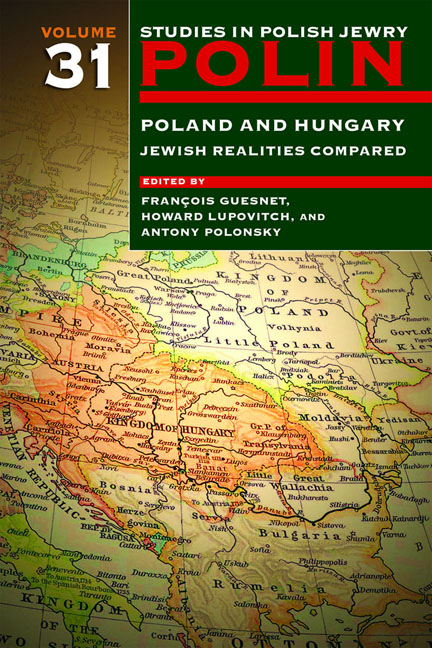Book contents
- Frontmatter
- Dedication
- Editors and Advisers
- Preface
- Polin
- Polin: Studies in Polish Jewry
- Contents
- Note on Place Names
- Note on Transliteration
- Part I POLAND AND HUNGARY: JEWISH REALITIES COMPARED
- JEWISH ACCULTURATION AND INTEGRATION
- JEWISH RELIGIOUS LIFE
- JEWS IN POPULAR CULTURE
- THE INTERWAR YEARS
- THE HOLOCAUST AND ITS AFTERMATH
- PERSONAL REFLECTIONS
- Part II NEW VIEWS
- Part III OBITUARIES
- Notes on the Contributors
- Index
Holocaust Remembrance in Hungary After the Fall of Communism
- Frontmatter
- Dedication
- Editors and Advisers
- Preface
- Polin
- Polin: Studies in Polish Jewry
- Contents
- Note on Place Names
- Note on Transliteration
- Part I POLAND AND HUNGARY: JEWISH REALITIES COMPARED
- JEWISH ACCULTURATION AND INTEGRATION
- JEWISH RELIGIOUS LIFE
- JEWS IN POPULAR CULTURE
- THE INTERWAR YEARS
- THE HOLOCAUST AND ITS AFTERMATH
- PERSONAL REFLECTIONS
- Part II NEW VIEWS
- Part III OBITUARIES
- Notes on the Contributors
- Index
Summary
Memory helps us to create our own continuity. Questions such as ‘Who are we?’, ‘Where do we come from?’, and ‘Where are we going?’ can only be answered if we know our past. We all belong to groups, but we all belong to ourselves as well. We try to create a continuous life-line from the stories that happened to us. The past is always adapted to the present, serving a teleological purpose. Trauma interrupts the life-line and the continuity of sense. Victims and also perpetrators, when confronted with their wrongdoing and shame, experience trauma. These are painful stories and they need time to heal. This is also the case in Hungary.
JEWS IN HUNGARY UNTIL THE DEPORTATIONS OF 1944
A large proportion of the Hungarian Jewish population was acculturated and assimilated. The Emancipation Act of 1867 gave Jews equal legal status and provided the conditions for unprecedented economic and cultural growth. A tolerant, liberal policy prevailed in respect to them in the second half of the nineteenth century. This changed for the worse from the 1880s as antisemitism intensified. Viktor Karády has reviewed the development of the statistical literature on the situation of the Jewish population in Hungary. The emergence of political antisemitism is reflected in the use made by political groups of statistics broken down according to religious denomination for militant antisemitic purposes in the 1890s. The first strongly Judaeophobic books were published at this time: these contrasted the situation of the Jews with that of the majority population from a statistical perspective and emphasized the advantageous position of the former in the achievement of middle-class status and financial well-being. In this context the topoi of ‘flooding’ and ‘invasion’ were already being used. As early as 1907 a numerus clausus was proposed in the Hungarian Parliament.
The concept of a ‘Jewish problem’ drawn from the statistics of Jewish upward social mobility also appeared on the political left. In 1917 with the publication of The Way of the Jews by Péter Ágoston, a professor at the legal academy in Nagyvárad, ‘the Jewish problem’, which had been swept under the carpet before, suddenly came into the limelight and the hitherto peripheral antisemitic voices grew louder.
- Type
- Chapter
- Information
- Polin: Studies in Polish Jewry Volume 31Poland and Hungary: Jewish Realities Compared, pp. 427 - 454Publisher: Liverpool University PressPrint publication year: 2018

